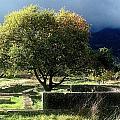Looking for design inspiration? Browse our curated collections!
Joined
2011
Followers
26
Visitors
467,275

Oracle and theater of Dodoni
Early worship at this site seems to reach back to the first half of the 3d millennium BCE (or earlier) with the worship of the Great Goddess the goddess of fertility and abundance. Archaeological evidence indicates that this ancient cult was already associated with the sacred oak tree, which remained central in worship and divination even after the sanctuary became the domain of Zeus in early Bronze Age. During the prehistoric era worship took place around the sacred oak tree in which the Sacred Couple (Zeus-Dione) lived. Dione represents the Great Goddess of Fertility. The prehistoric Great Goddess (Gea, Gaia = the Earth) was transformed into Zeus' companion, Dione and Zeus, the divine couple resided under the oak tree. From its foundation and until the end of the 5th century BCE worship took place in the open, under the sacred oak tree where the Zeus and Dione lived. The priests, delivered Zeus' divinations by interpreting the rustling of the sacred oak's leaves and the flight of wild pigeons that nested in its foliage. The sanctuary was finally razed and the sacred Oak uprooted when Emperor Theodosius banned all Hellenic rites and festivals in 393 BCE. Now in its place a new oak tree has grown that was planted by a pious man. The ancient theater of Dodoni in Epirus is one of the largest and best preserved ancient greek theaters. The capacity of the theater is 18,000 spectators. The theater of Dodoni was part of the Panhellenic sanctuary of Dodoni and was constructed in the 3rd century B.C. by King Pyrros of Epirus (297-272 B.C.) who wanted to decorate the areas of his kingdom with architectural monuments and buildings. The hollow of the theater of Dodoni was placed at the foot of Mount Tomaros in a natural cavity to take advantage of the sloping terrain, which was the usual practice in the construction of ancient greek theaters. The orchestra of the theater is not a complete cycle and has a larger diameter 18.70 m. The theater suffered successive disasters, reconstructions and formations in the centuries that followed the decline of the kingdom of Epirus and during the Roman conquest was used as an arena. From the 4th century AC ceased to function. The first excavations and restorations of the ancient site of Dodoni began in 1875 and continue until today. nowadays the theater of Dodoni hosts some performances during the summer months